Numerical Simulation of the Effect of Heat Transfer and Cooling of a Coal Pillar Oxidation Heat Source by a Bending Heat Pipe
Abstract
1. Introduction
2. Construction of Mathematical Model of Heat Transfer in Bending Heat Pipe
2.1. Analysis of Heat Transfer Principle of Bending Heat Pipe
2.2. Basic Assumptions of the Model
- (1)
- The assumption that the surface temperature in a heat pipe module within a coal pillar is constant: It is assumed that the surface temperature of the module remains unchanged and is not affected by the fluctuation of other external factors. This assumption aims to eliminate the interference of dynamic changes in the external environment in the heat transfer process to evaluate the heat transfer characteristics of the heat pipe itself more accurately. This assumption is helpful for enhancing the analyticity of experimental data and the reliability of our model verification.
- (2)
- Radial heat transfer hypothesis: The heat conduction in the coal pillar only occurs along the radial direction, and all heat that is released can be transferred directly into the heat pipe via heat conduction, without considering other heat transfer mechanisms. This assumption is based on the actual working mechanism of the heat pipe in the coal pillar, that is, that the heat is absorbed from the inside of the coal body along the radial direction and dissipates heat to the outside. The simplified treatment can effectively reduce the dimensionality of the model, help us focus on the key role of the heat pipe in the radial heat conduction process, and improve the practicability of the model.
- (3)
- The assumption of constant thermophysical properties of loose coal: It is assumed that the thermal conductivity, density, porosity, and particle size distribution of coal remain constant during the simulation. This assumption is based on the consideration that the experimental period is short, and the thermal properties of coal do not change significantly. This treatment can simplify the structure of the control equation, so that the analysis is focused on the heat transfer efficiency of the heat pipe and avoids the interference of thermophysical parameters.
- (4)
- Ignoring the thermal resistance of the pipe wall: As a pipe wall has relatively low thermal resistance and a coal body is loose, the thermal resistance generated by the heat conduction of the pipe wall is ignored. This assumption is based on the fact that the thermal conductivity of the heat pipe is much higher than that of the surrounding coal, and its thermal resistance can be ignored in the simplified model. This simplification helps focus this study on the heat exchange process at the coal–heat pipe interface and improve the characterization ability of the model.
- (5)
- The assumption of heat insulation and heat preservation of the experimental system: We ignore any heat exchange of the experimental coal body with the external environment to ensure that the simulated thermal response is purely derived from the heat transfer effect of the heat pipe. This condition is helpful for improving the accuracy and explanatory power of numerical simulation.
2.3. Heat Transfer Control Equation of Heat Pipe
3. Heat Transfer Model and Parameter Setting for Bending Heat Pipe
3.1. Model Construction and Grid Division
3.2. Initial Conditions and Parameter Settings
3.3. Verification of Numerical Simulation
4. Results and Discussion
4.1. The Effect of a Bending Heat Pipe on the Coal’s Temperature Field
4.2. Effect of Spacing on Distribution Characteristics of Coal’s Temperature Field
4.2.1. Heat Transfer Effect of a 30 cm Spacing Between Bending Heat Pipes
4.2.2. Heat Transfer Effect of a 40 cm Spacing Between Bending Heat Pipes
4.2.3. Heat Transfer Effect of a 50 cm Spacing Between Bending Heat Pipes
5. Conclusions
- (1)
- Through numerical simulation and experimental comparison, the maximal difference in temperature between the simulated temperature field of a bending heat pipe and the experimental temperature field under identical working conditions was 3.8 °C, which proves the feasibility of the model. It was further shown that the model can meet the expected demand of heat transfer and cooling by a bending heat pipe in mining engineering.
- (2)
- A heat transfer model of two bending heat pipes with different spacings of 30 cm, 40 cm, and 50 cm was established. Six different working conditions were established to simulate and analyze how the spacing between heat pipes affected their heat transfer effect in a coal pillar’s crushing zone. At 24 h after the heat transfer, the coal temperature curve of each section near the heat pipe displayed a “wave”-like variation trend. As the spacing between two bending heat pipes increased, heat transfer of the temperature field within the broken zone inside the coal body was obviously weakened.
- (3)
- The heat transfer effects induced by the three different spacings between bending heat pipes under two temperature field conditions were compared. The best heat transfer effect can be achieved at a spacing of 30 cm, with an efficiency of 36.7%. At a spacing of 50 cm, the temperature suppression effect was reduced because of the limited heat transfer radius of the bent heat pipe. Overall, 30–40 cm is the best spacing between bending heat pipes, achieving both a heat transfer effect and cost-effectiveness. A similar-ratio design based on this optimal spacing can be applied directly to a mining site, which can effectively decrease costs while ensuring heat transfer.
- (4)
- Our research results provide a theoretical reference for the use of bending heat pipes to inhibit the spontaneous combustion of coal pillars, which to a certain extent can lead to early prevention and control of the oxidation of heat sources in the broken area of coal pillars. Due to the length of our experimental period, the experimental conditions have certain objective limitations. In the future, this experiment can be optimized by prolonging the monitoring time and increasing the density of temperature monitoring points. In order to effectively prevent and control spontaneous combustion of coal pillars under actual mining conditions, the synergistic effect of multiple bending heat pipes, the phase change law of the working medium inside the heat pipes, and the field conditions should be studied in depth.
Author Contributions
Funding
Data Availability Statement
Acknowledgments
Conflicts of Interest
Abbreviations
| CSC | Coal spontaneous combustion |
References
- Wang, Q.X.; Huang, Q.X.; He, Y.P.; Fan, D.L.; Chen, S.S.; Wang, W. Research on reasonable coal pillar staggered distance in shallow multi-seam mining. Disco. Appl. Sci. 2024, 6, 361. [Google Scholar] [CrossRef]
- Xu, Q.Y.; Bai, J.B.; Yan, S.; Wang, R.; Wu, S.X. Numerical Study on Soft Coal Pillar Stability in an Island Longwall Panel. Adv. Civ. Eng. 2021, 2021, 8831778. [Google Scholar] [CrossRef]
- Gu, W.; Zhang, H.; Han, Z.F.; Tang, H.K.; Pei, J.Y.; Wu, S.X.; Xu, D.L. Research on the Bearing Characteristics of Narrow Coal Pillars in Double-Roadway Excavation Under the Influence of Full Dynamic Pressure. Appl. Sci. 2025, 15, 7148. [Google Scholar] [CrossRef]
- Liu, Y.; Qi, X.Y.; Luo, D.Y.; Zhang, Y.Q.; Yin, D.X. Research on the Law of Coal Pillar Spontaneous Combustion and Fire Prevention and Control Technology. ACS Omega 2024, 9, 18973. [Google Scholar] [CrossRef]
- Ardehjani, E.A.; Ataei, M.; Sereshki, F.; Mirzaghorbanali, A.; Aziz, N. Impact of CO2 and methane adsorption and emission on coal’s mechanical properties and pillar stability: Implications for ECBM and CO2 sequestration. Energy 2025, 333, 137438. [Google Scholar] [CrossRef]
- Sun, L.L.; Yang, J.L.; Guo, Z.G.; Shi, Q.L.; Qi, G.S.; Zhou, F.G. Numerical and experimental Investigation of coal pillar crushing and spontaneous combustion in shallow and closely spaced coal seams. Adv. Power Technol. 2025, 36, 104848. [Google Scholar] [CrossRef]
- Zheng, W.C.; Yang, S.Q.; Li, W.Z.; Wang, J. Research of inorganic fire-extinguishing materials on preventing and controlling gas and coal spontaneous combustion in the narrow coal pillar and adjacent goaf. Fire Mater. 2020, 44, 660–672. [Google Scholar] [CrossRef]
- Zubov Vladimir, P.; Golubev Dmitrii, D. Prospects for the use of modern technological solutions in the flat-lying coal seams development, taking into account the danger of the formation of the places of its spontaneous combustion. J. Min. Inst. 2021, 250, 534–541. [Google Scholar] [CrossRef]
- Mária, P.; Andrej, K.; Milan, M.; Patrik, N. The Effect of Convection on the Thermal Power Change of Loop Thermosyphon. MATEC Web Conf. 2020, 328, 03008. [Google Scholar] [CrossRef]
- Pekur, D.V.; Nikolaenko, Y.E.; Kravets, V.Y.; Kozak, D.V.; Sorokin, V.M.; Nikolaienko, T.Y. Comparison of thermal characteristics of three modifications of gravity heat pipe with threaded evaporator at different inclination angles. Therm. Sci. Eng. Prog. 2023, 46, 102219. [Google Scholar] [CrossRef]
- Anand, R.S.; Li, A.; Huang, W.B.; Chen, J.W.; Li, Z.B.; Ma, Q.S.; Jiang, F.M. Super-long gravity heat pipe for geothermal energy exploitation - A comprehensive review. Renew. Sust. Energy Rev. 2024, 193, 114286. [Google Scholar] [CrossRef]
- Feng, C.; Gibbons, M.J.; Marengo, M.; Chandra, S. A novel ultra-large flat plate heat pipe manufactured by thermal spray. Appl Therm Eng. 2020, 171, 115030. [Google Scholar] [CrossRef]
- Patel, K. An efficient optimization and comparative analysis of ammonia and methanol heat pipe for satellite application. Energy Convers. Manag. 2018, 165, 382–395. [Google Scholar] [CrossRef]
- Qian, N.; Jiang, F.; Chen, J.J.; Fu, Y.C.; Zhang, J.Z.; Xu, J.H. Heat transfer enhancement by diamond nanofluid in gravity heat pipe for waste heat recovery. Funct. Diam. 2022, 2, 236–244. [Google Scholar] [CrossRef]
- Liu, L.M.; Guo, Z.A.; Du, Z.Y.; He, X.Q.; Gu, H.Y. Experimental research on the coupling heat transfer characteristics of the system components of the space heat pipe cooled reactor under the power variation conditions. Appl. Therm. Eng. 2025, 278, 127456. [Google Scholar] [CrossRef]
- Zhang, X.S.; Sun, H.W.; Huang, J.J.; Sun, P.W.; Wei, X.Y. Control Strategy Study for a Heat Pipe Cooled Nuclear Reactor. SSRN Electron. J. 2023, 190, 109849. [Google Scholar] [CrossRef]
- Zhang, X.F.; Zhou, X.X. Experimental Study on Wall Temperature and Heat Transfer Characteristics of Gravity Heat Pipe by Heat Input Power and Working Materials. Combust. Sci. Technol. 2023, 195, 2311–2326. [Google Scholar] [CrossRef]
- Zhang, X.G.; Wang, T.; Zhang, X.H.; Ge, S.C. Analysis of multiple factors influencing the efficiency of gravity thermal pipe waste heat recovery: A case study of heat accumulation management in spoil tips. Energy 2025, 322, 135526. [Google Scholar] [CrossRef]
- Sun, G.Y.; Wu, Y.; Gao, W. The Heat-Dissipation and Dehumidification System of the Hybrid Multi-Layer Gravity Heat Pipe Applied to Granary. Mod. Appl. Sci. 2019, 13, 76. [Google Scholar] [CrossRef]
- De León-Ruiz, J.E.; Beltrán-Chacón, R.; Carvajal-Mariscal, I.; Venegas, M.; De La Cruz-Ávila, M. Effect of vessel dimensional ratio on heat conveyance capabilities of gravity-assisted heat pipes: Theoretical and experimental approach. Therm. Sci. Eng. Prog. 2023, 45, 102091. [Google Scholar] [CrossRef]
- Dai, J.; Tian, Z.J.; Shi, X.Y.; Lu, Y.; Chi, W.L.; Zhang, L. Research progress on gravity heat pipe technology to prevent spontaneous combustion in coal storage piles. MRS Commun. 2024, 14, 480–488. [Google Scholar] [CrossRef]
- Zhai, Y.; Ling, Z.K.; Zhao, X.; Dong, Z.F. Effects of Structure Parameters of Gravity-Type Heat Pipe on Heat Transfer Characteristics for Waste Heat Recovery from Mine Return Air. Energies 2024, 17, 6495. [Google Scholar] [CrossRef]
- Xie, A.H.; Zhang, B.L.; Zhang, X.H.; Zhang, Y.X.; Cao, Z.K. Simulation Study on the Influence of Chimney Structure on the Efficiency of Gravity Heat Pipes for Controlling Spontaneous Combustion in Coal Waste Rock Piles. Combust. Sci. Technol. 2025, 197, 2578–2597. [Google Scholar] [CrossRef]
- Tong, J.M.; Zhang, Y.B.; Zhao, X.H.; Shi, H.; Zhang, Y.H. Influence of heat pipe layout parameters on the cooling effect of spontaneous combustion coal gangue dumps. Sci. Rep. 2024, 14, 27056. [Google Scholar] [CrossRef]
- Senthil Kumar, R.; Vaidyanathan, S.; Sivaraman, B. Effect of copper nanofluid in aqueous solution of long chain alcohols in the performance of heat pipes. Heat Mass Transf. 2015, 51, 181–193. [Google Scholar] [CrossRef]
- Xiao, Y.; Zhong, K.Q.; Tian, J.Y.; Yin, L.; Tian, Y.; Shu, C.M. Thermal extraction from a low-temperature stage of coal pile spontaneous combustion by two-phase closed thermosyphon. J. Therm. Anal. Calorim. 2021, 144, 587–597. [Google Scholar] [CrossRef]
- Wei, G.M.; Ma, L.; Wang, Z.P.; Wen, H.; Guo, R.Z.; Yu, W.Z.; Liu, S.M. Key Parameters of Preventing Spontaneous Combustion of Coal Stockpile Based on Heat Transfer Technology by a Heat Pipe. Combust. Sci. Technol. 2022, 194, 2916–2932. [Google Scholar] [CrossRef]
- Gselman, U.; Peršak, V.; Goričanec, D. Numerical Analysis of Low-Enthalpy Deep Geothermal Energy Extraction Using a Novel Gravity Heat Pipe Design. Sustainability 2024, 16, 6660. [Google Scholar] [CrossRef]
- Guo, J.; Chen, C.M.; Wen, H.; Cai, G.B.; Liu, Y. Prediction model of goaf coal temperature based on PSO-GRU deep neural network. Case Stud. Therm. Eng. 2023, 53, 103813. [Google Scholar] [CrossRef]
- Wang, J. Numerical Simulation Study on Effect of Gravity Heat Pipe on Distribution of Coal Fired Combustion Spontaneous Temperature Field; Xi’an University of Science and Technology: Xi’an, China, 2018. [Google Scholar]
- Chen, Q.H.; Sun, M.H.; Su, G.Y. Influence of Gravity Heat Hipe on Temperature Field in Coal Pile. Saf. Coal Mines 2018, 49, 211–214. [Google Scholar] [CrossRef]
- Li, B. Research on Thermodynamic Characteristies and Heat Transfer Method of Uncontrolled Fire in Coal Gangue Dump; Xi’an University of Science and Technology: Xi’an, China, 2017. [Google Scholar]
- Lu, X.; Liu, J.; Gao, L.H.; Xiao, Y.; Tong, X.L.; Deng, J. Experimental investigation on thermal-electric characteristics of curved thermosyphon-thermoelectric generator in waste heat recovery of coal spontaneous combustion. Appl. Therm. Eng. 2024, 244, 122638. [Google Scholar] [CrossRef]
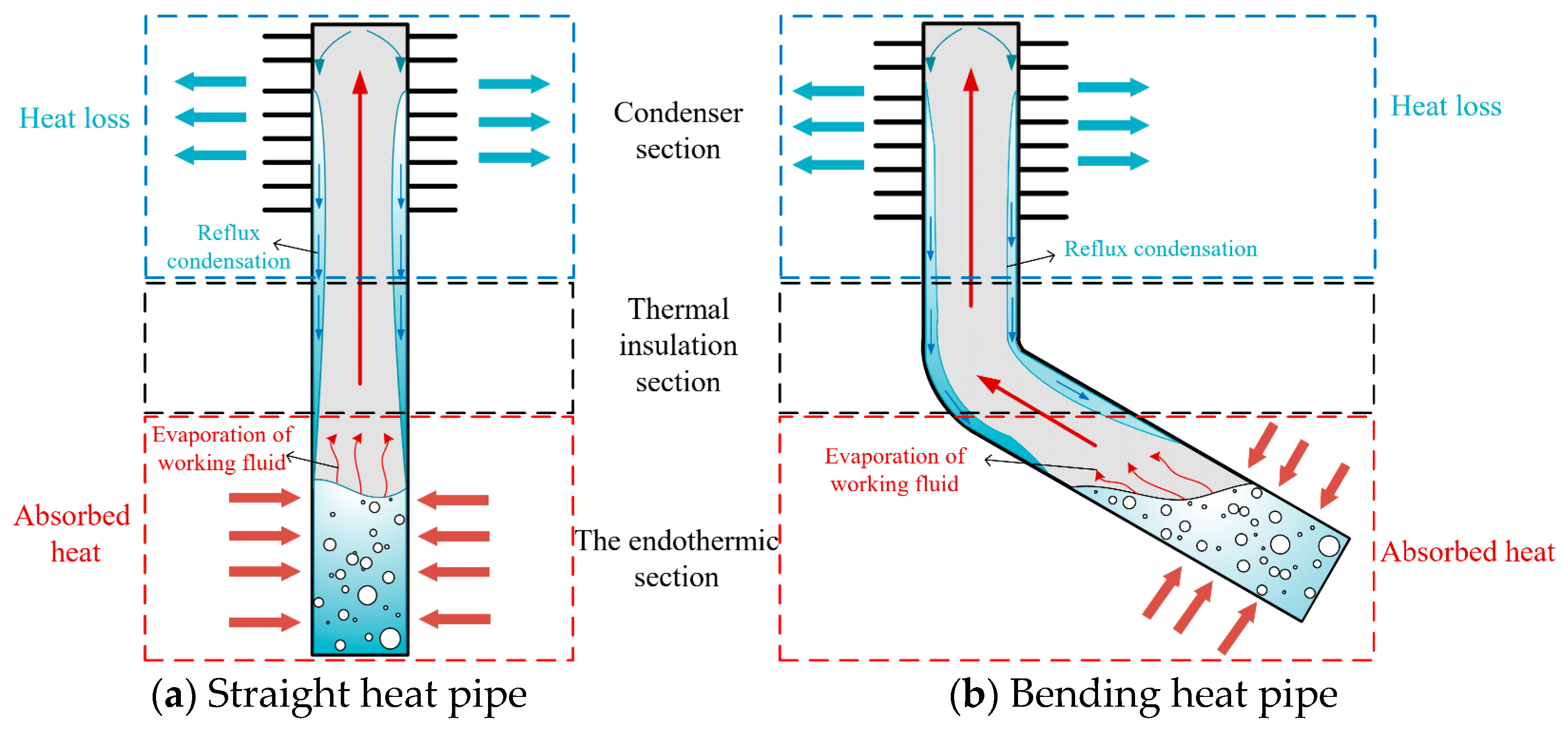
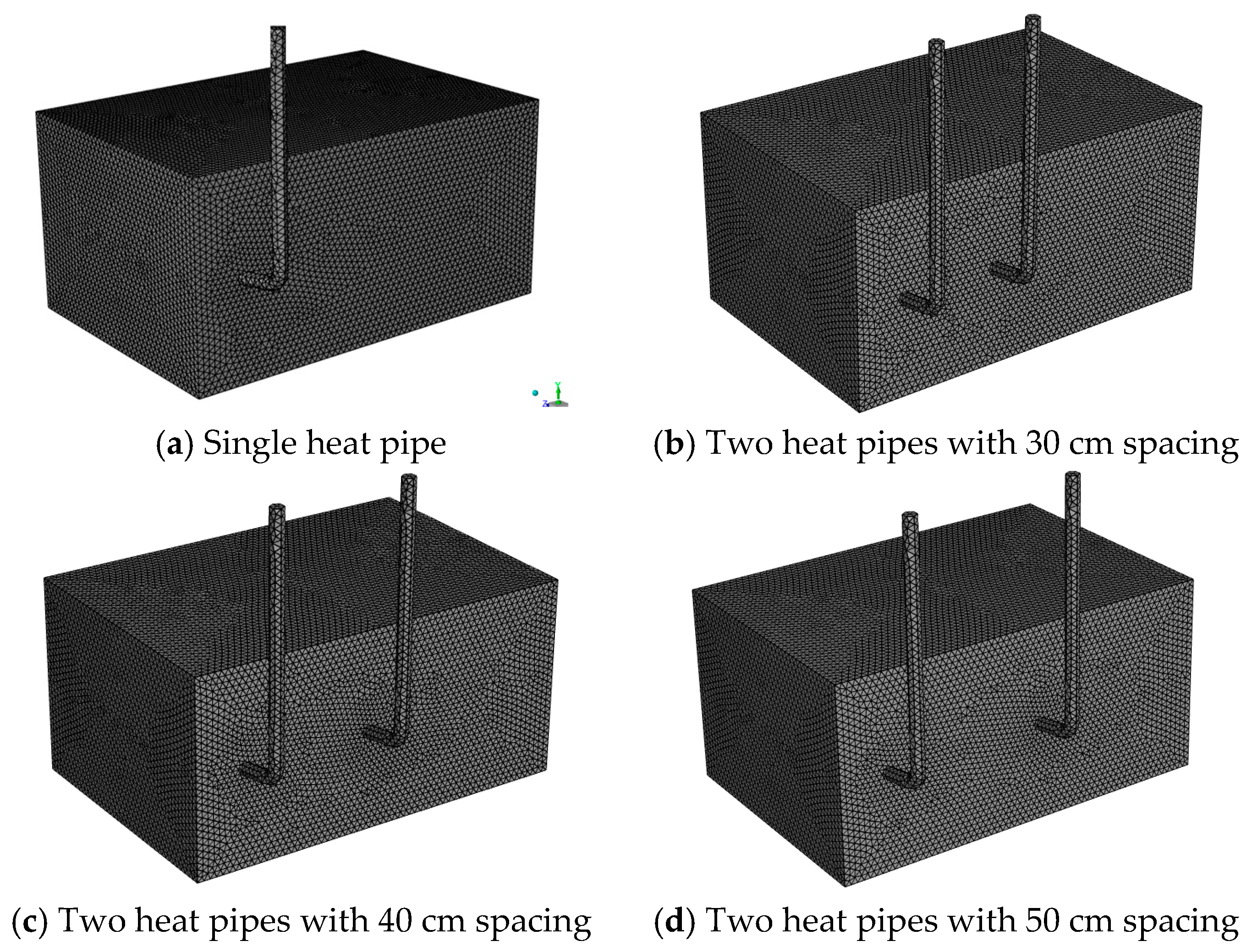
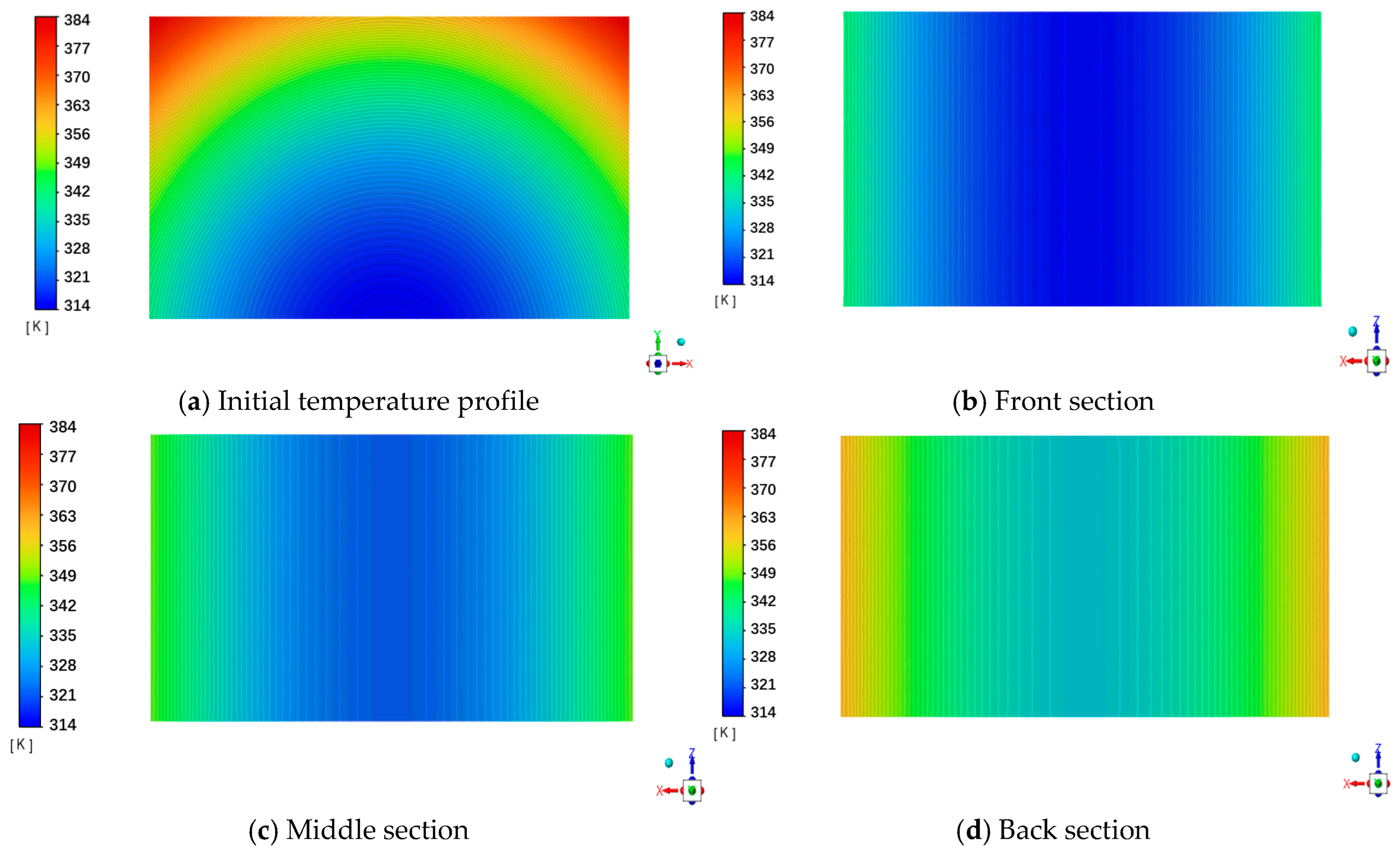
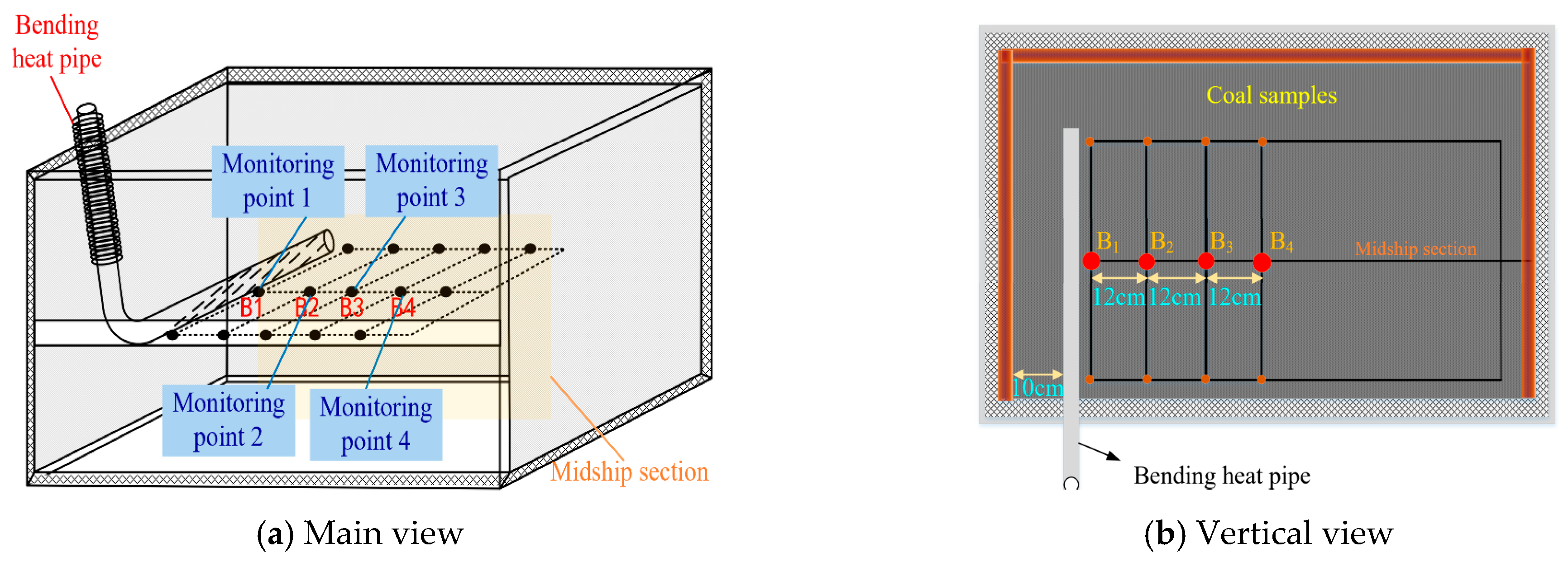
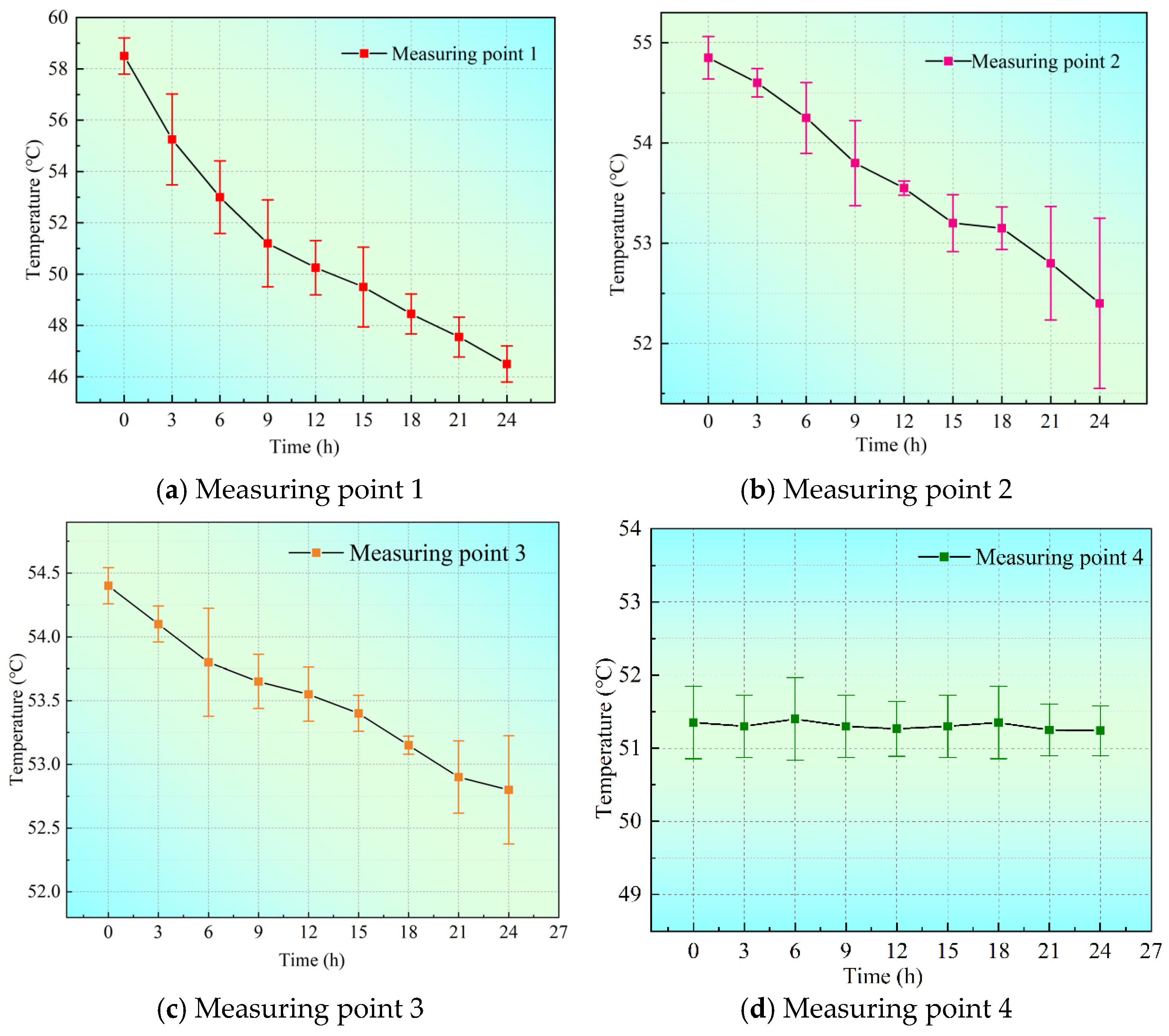
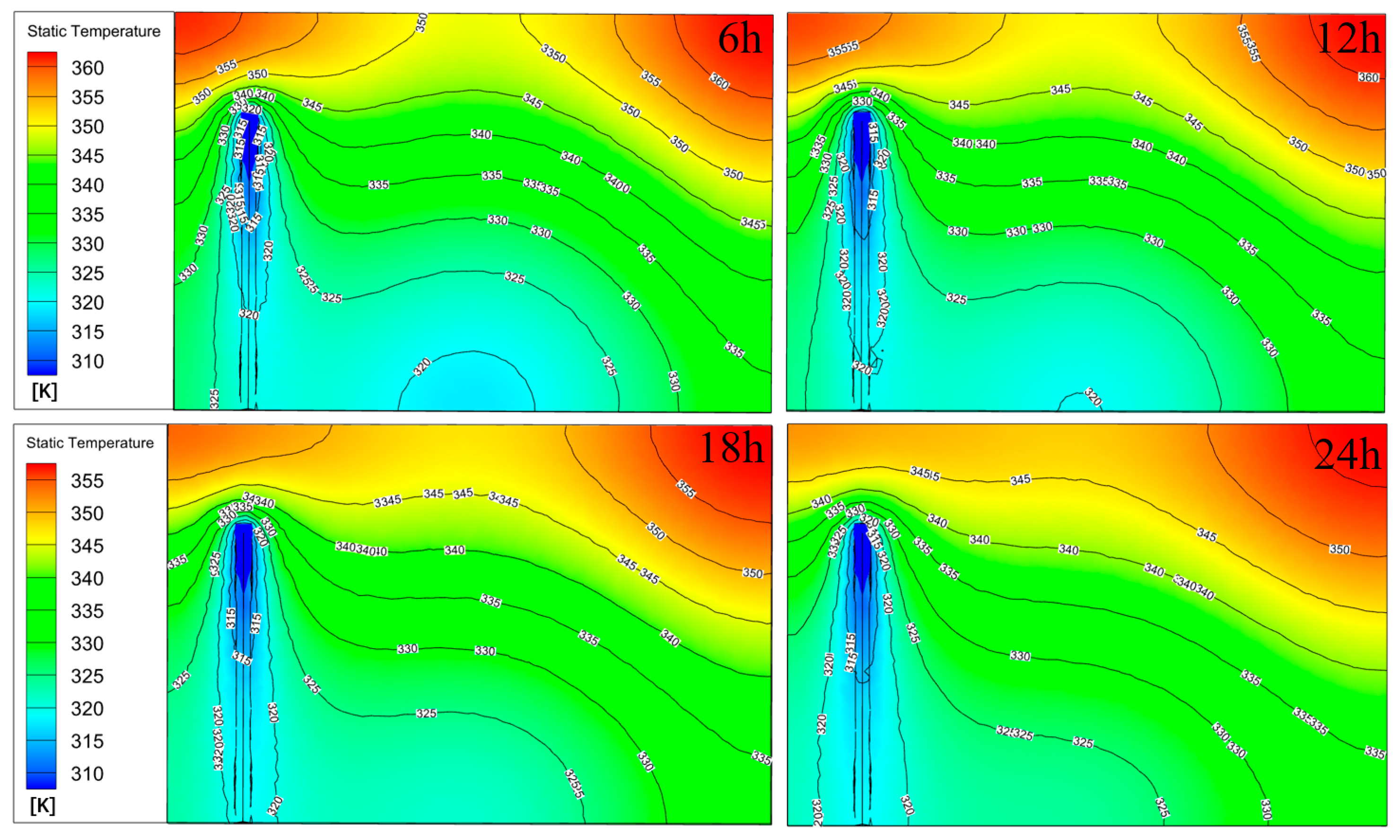
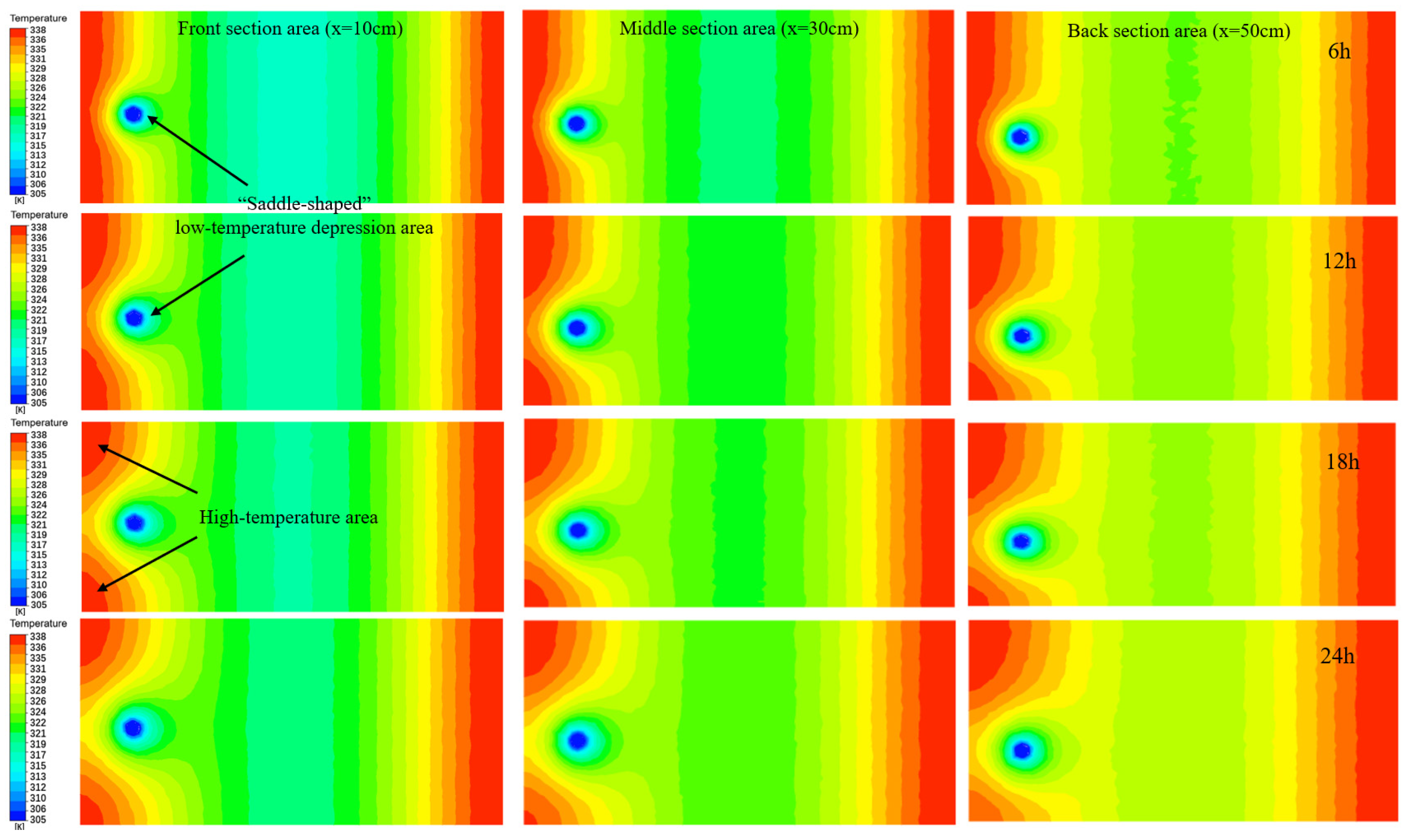

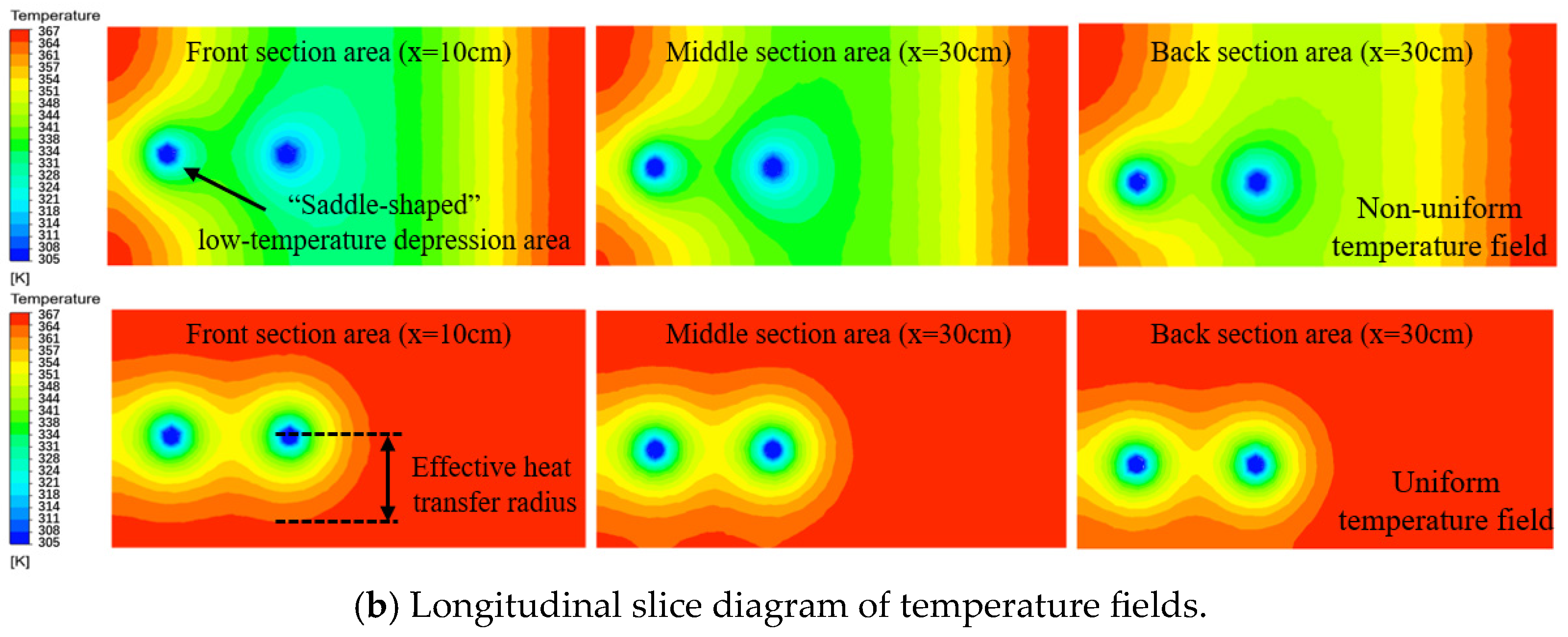

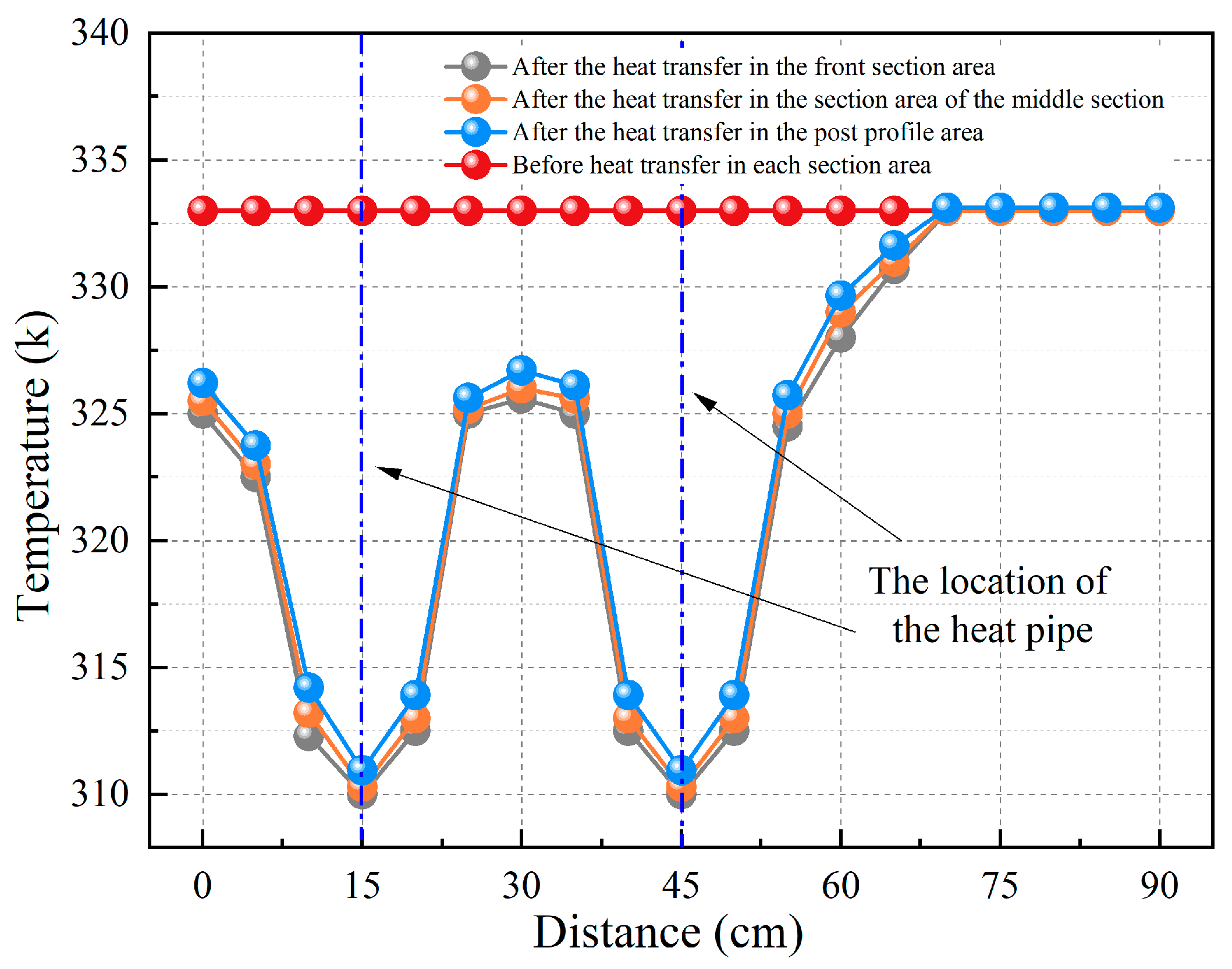
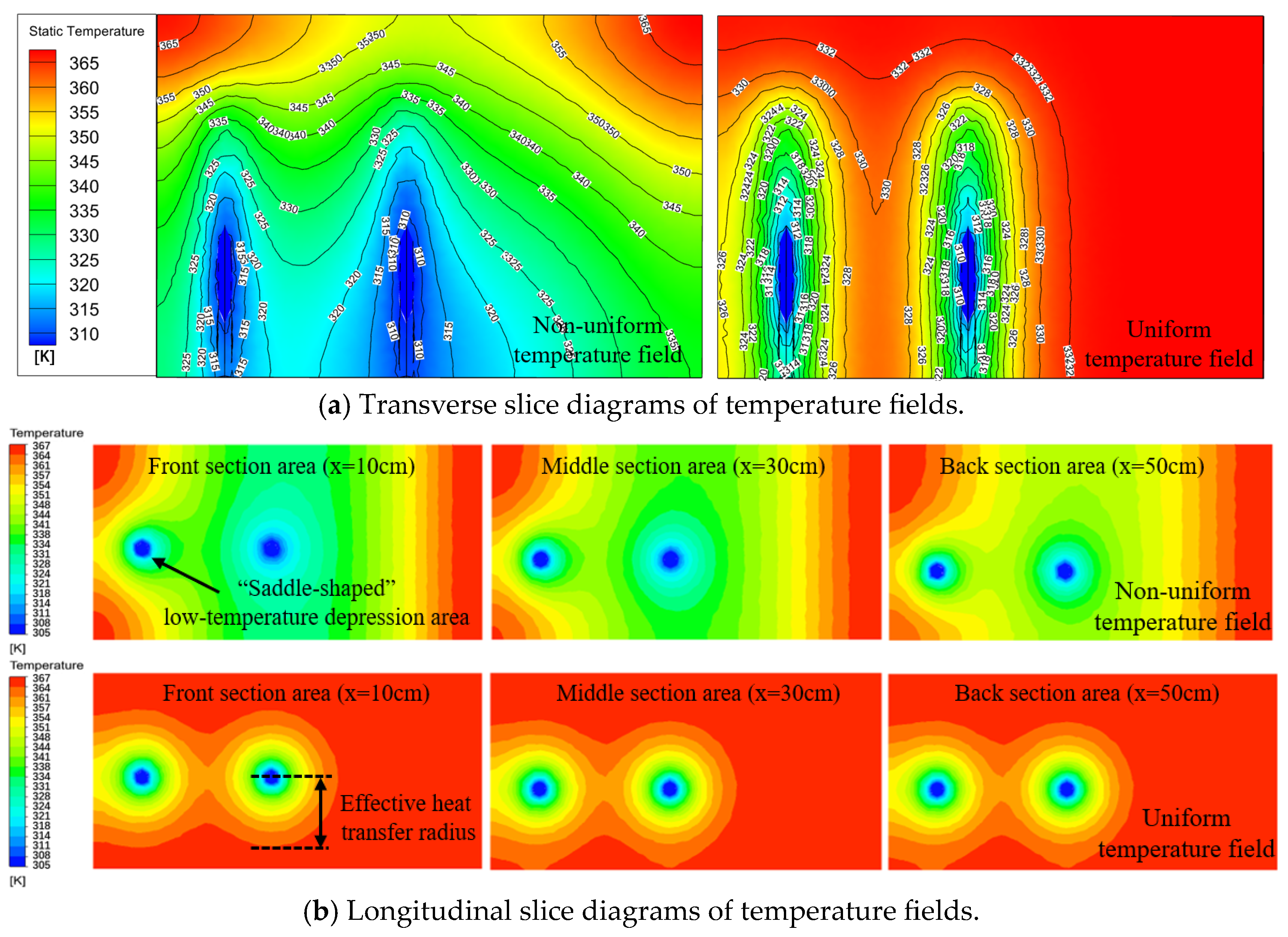

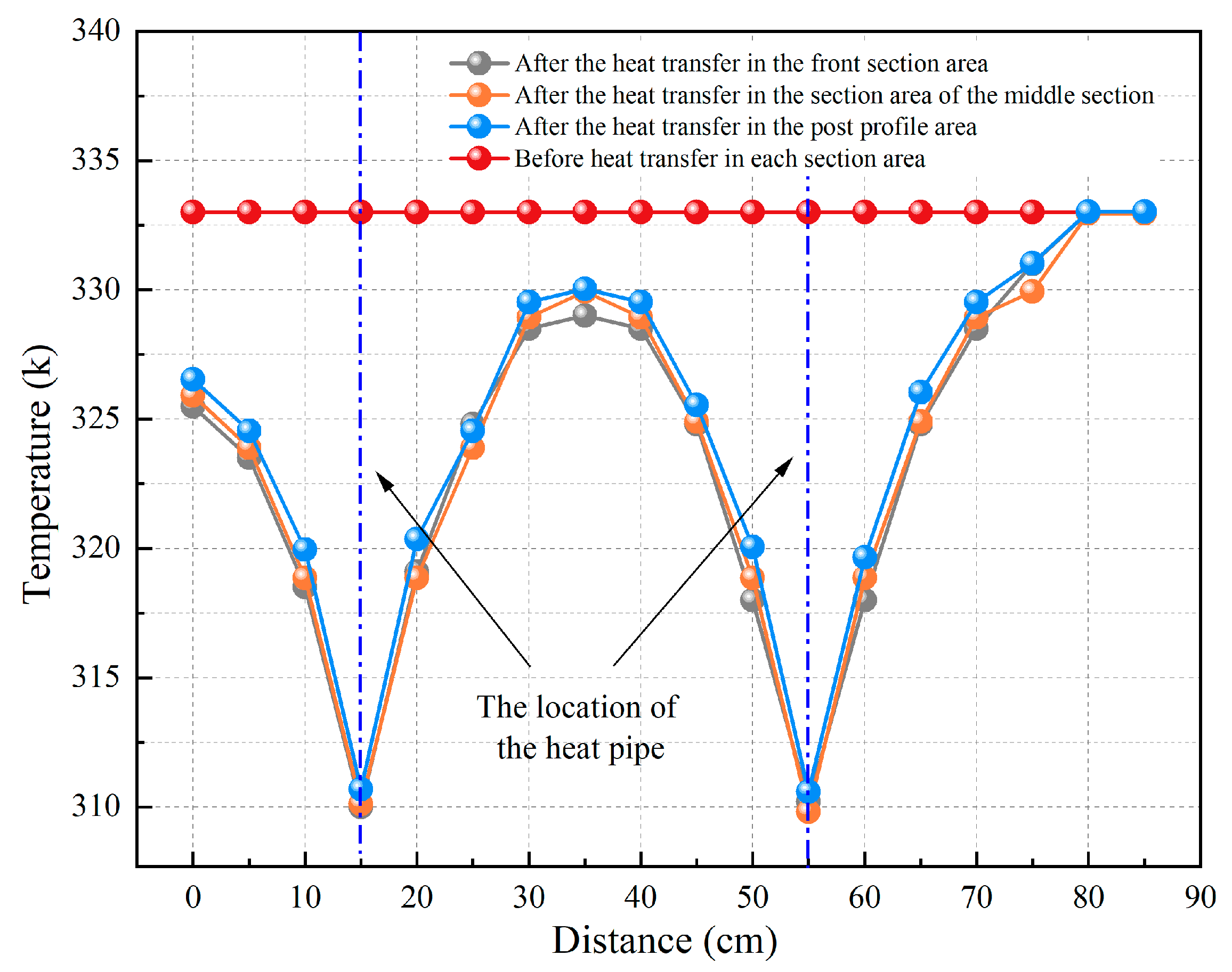
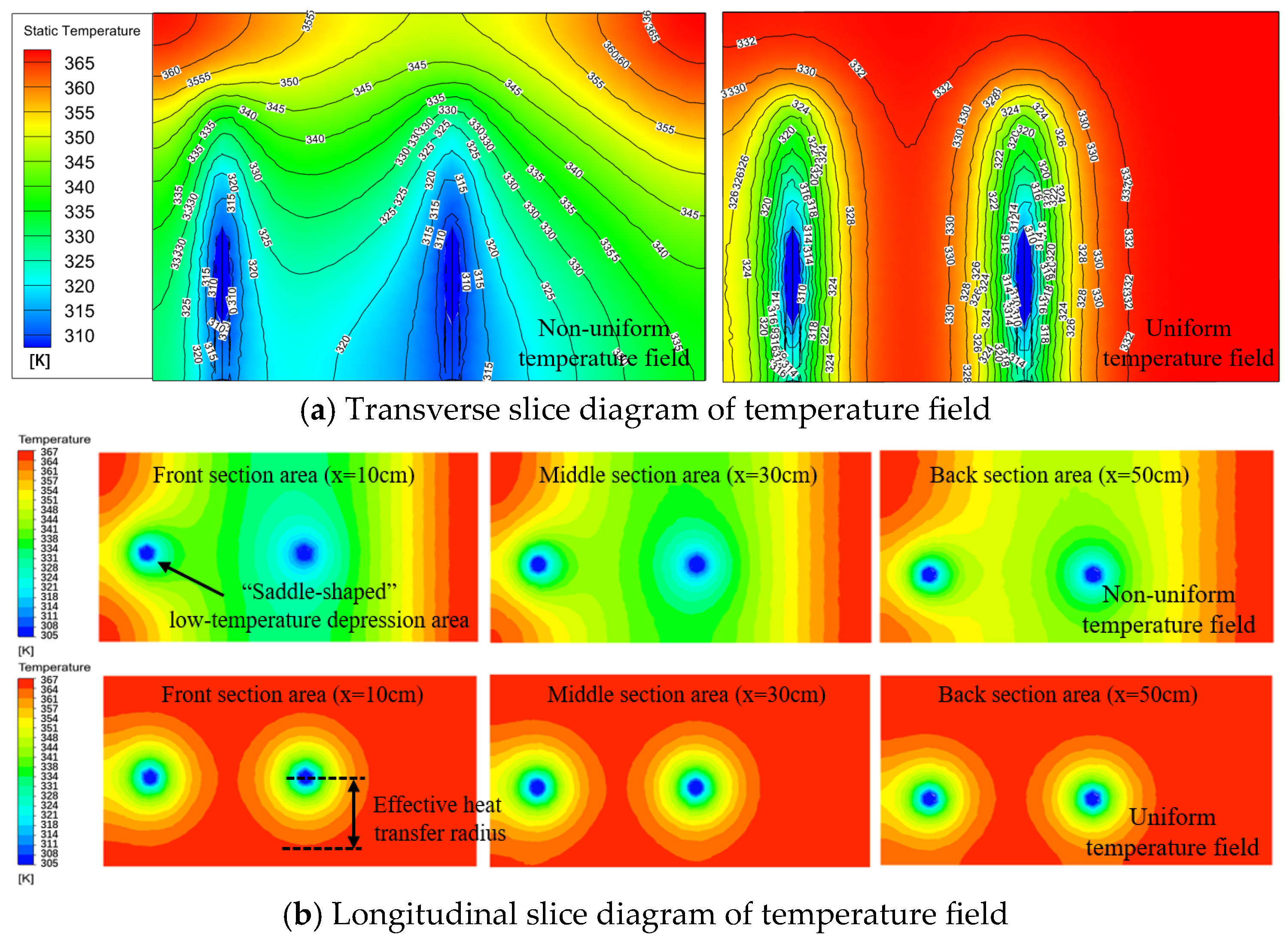

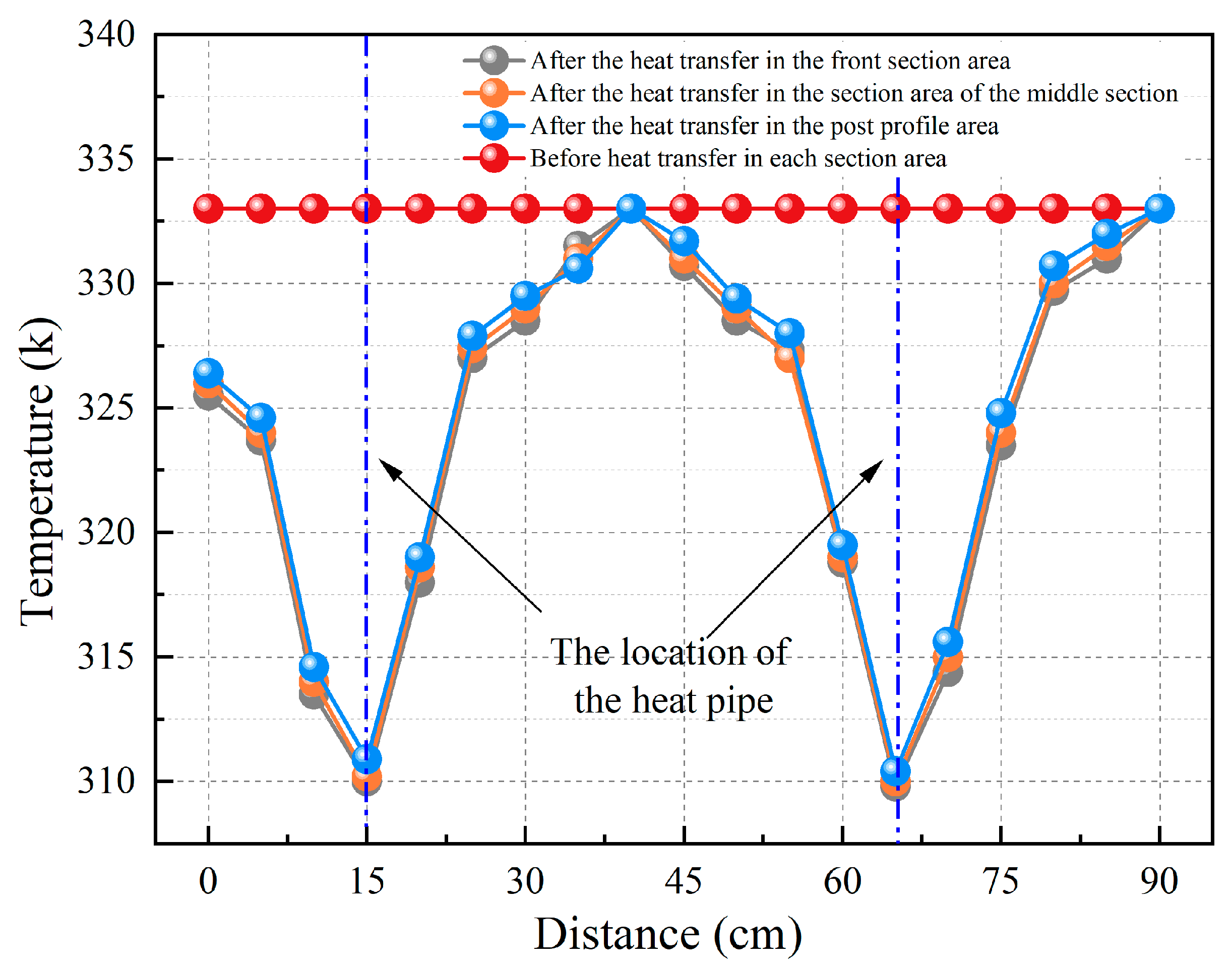
| Parameter | Value | Unit |
|---|---|---|
| Length of heat pipe’s heat absorption section/le | 0.6 | m |
| Length of heat pipe’s condensation section/lc | 0.6 | m |
| Coal pile’s density/ρ | 1215 | kg·m−3 |
| Coal pile’s specific heat capacity/c | 1.189 | J·kg−1·K−1 |
| Coal pile’s thermal conductivity/k | 0.121 | W·m−1·K−1 |
| Heat pipe’s outer diameter/do | 0.038 | m |
| Heat pipe’s inner diameter/di | 0.035 | m |
| Heat pipe shell’s specific heat capacity/ci | 450 | J·kg−1·K−1 |
| Heat pipe’s thermal conductivity/ki | 48 | W/m |
| Heat transfer coefficient of inner surface of heat pipe’s heat absorption section/α1 | 3500 | W·m−2·K− |
| Heat transfer coefficient of inner surface of heat pipe’s condensation section/α2 | 4200 | W·m−2·K−1 |
| Equivalent thermal conductivity/k | 1.86 × 105 | W/(m·K) |
| Monitoring Point | Final Temperature of Experiment/°C | Simulated Final Temperature/°C | Absolute Error/°C | Relative Error/% |
|---|---|---|---|---|
| B1 | 47.0 | 46.0 | 1.0 | 2.13 |
| B2 | 51.8 | 53.0 | 1.2 | 2.26 |
| B3 | 52.5 | 53.1 | 0.6 | 1.13 |
| B4 | 51.48 | 51.0 | 0.48 | 0.93 |
| Spacing/cm | Uniform Temperature Field | Non-Uniform Temperature Field | ||
|---|---|---|---|---|
| Maximum Temperature Difference/°C | Cooling Efficiency/% | Maximum Temperature Difference/°C | Cooling Efficiency/% | |
| 30 | 22 | 36.7 | 20 | 27.8 |
| 40 | 22 | 36.7 | 10 | 13.9 |
| 50 | 0 | 0 | 6 | 10.2 |
Disclaimer/Publisher’s Note: The statements, opinions and data contained in all publications are solely those of the individual author(s) and contributor(s) and not of MDPI and/or the editor(s). MDPI and/or the editor(s) disclaim responsibility for any injury to people or property resulting from any ideas, methods, instructions or products referred to in the content. |
© 2025 by the authors. Licensee MDPI, Basel, Switzerland. This article is an open access article distributed under the terms and conditions of the Creative Commons Attribution (CC BY) license (https://creativecommons.org/licenses/by/4.0/).
Share and Cite
Guo, J.; Li, S.; Wu, Y.; Chen, C.; Liu, Y.; Wang, L.; Zhang, X. Numerical Simulation of the Effect of Heat Transfer and Cooling of a Coal Pillar Oxidation Heat Source by a Bending Heat Pipe. Processes 2025, 13, 3298. https://doi.org/10.3390/pr13103298
Guo J, Li S, Wu Y, Chen C, Liu Y, Wang L, Zhang X. Numerical Simulation of the Effect of Heat Transfer and Cooling of a Coal Pillar Oxidation Heat Source by a Bending Heat Pipe. Processes. 2025; 13(10):3298. https://doi.org/10.3390/pr13103298
Chicago/Turabian StyleGuo, Jun, Shuai Li, Yunfei Wu, Changming Chen, Yin Liu, Lei Wang, and Xuanchi Zhang. 2025. "Numerical Simulation of the Effect of Heat Transfer and Cooling of a Coal Pillar Oxidation Heat Source by a Bending Heat Pipe" Processes 13, no. 10: 3298. https://doi.org/10.3390/pr13103298
APA StyleGuo, J., Li, S., Wu, Y., Chen, C., Liu, Y., Wang, L., & Zhang, X. (2025). Numerical Simulation of the Effect of Heat Transfer and Cooling of a Coal Pillar Oxidation Heat Source by a Bending Heat Pipe. Processes, 13(10), 3298. https://doi.org/10.3390/pr13103298





